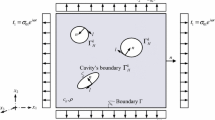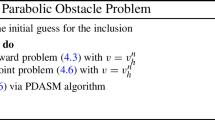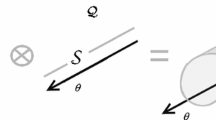Abstract
In this work, a general boundary element procedure is proposed to obtain the effective elastic tensor of solids containing randomly distributed micro-cavities in terms of its primary elastic properties. The average-field theory and a special boundary element formulation are combined to carry out a statistical analysis on the numerical results obtained for a Representative Volume Element (RVE). The two-dimensional isotropic material is simulated as a homogeneous matrix containing cylindrical holes. In the proposed implementation each hole boundary is modeled with a single boundary element. The average variables of the micro-field are evaluated using boundary-only data, which leads to a formulation particularly suitable for Boundary Element Methods. Expressions for effective elastic properties as a function of the micro-fields for both isotropic and transversally isotropic hypothesis are derived. Finally, the methodology is illustrated with some application examples and the results are compared with analytical and experimental results.













Similar content being viewed by others
References
Hu N, Wang B, Tan GW, Yao ZH, Yuan WF (2000) Compos Sci Technol 60:1811
Yang Q-S, Qin Q-H (2004) Eng Anal Bound Elem 28:919
Dong CY, Lee KY (2006) Eng Anal Bound Elem 30:662
Okada H, Fukui Y, Kumazawa N (2001) Comput Struct 79:1987
Dong CY, Lo SH, Cheung YK (2002) Eng Anal Bound Elem 26:471
Knight MG, Wrobel LC, Henshall JL (2003) Compos Struct 62:341
Wang J, Crouch SL, Mogilevskaya SG (2003) Eng Anal Bound Elem 27:789
Mogilevskaya SG, Crouch SL (2001) Int J Numer Meth Eng 52:1069
Zohdi TI (2002) In: Computational modeling and design of new random microheterogeneous materials. CISM Course notes, Udine Italy
Nemat-Nasser S, Hori M (1999) In: Micromechanics: overall properties of heterogeneous solids. Elsevier
Hori M, Nemat-Nasser S (1999) Mech Mater 31:667
Henry DP, Banerjee PK (1991) Int J Numer Meth Eng 31:369
Buroni FC, Marczak RJ (2006) In: Cardona A, Nigro N, Songzogni V, Storti M (eds) Mecánica Computacional, vol XXV. Santa Fé, Argentina, p 2747
Buroni FC, Marczak RJ (2007) A family of hole boundary elements for modeling materials with cylindrical voids. Accepted in: Eng Anal Bound Elem. doi:https://doi.org/10.1016/j.enganabound.2007.11.003
Buroni FC, Marczak RJ (2006) In: Cardona A, Nigro N, Songzogni V, Storti M (eds) Mecánica computacional, vol XXV. Santa Fé, Argentina, p 2835
Banerjee PK (1994) In: The boundary element methods in engineering. Mc Graw-Hill
Brebbia CA, Dominguez J (1992) Boundary elements. An introductory course. Computational Mechanics Publications. McGraw-Hill
Kanit T, Forest S, Galliet I, Mounoury V, Jeulin D (2003) Int J Solids Struct 40:3647
Dong CY (2006) Int J Solids Struct 43:7919
Öchsner A (2004) Numerical simulation of the mechanical behavior of cellular materials. Research report, Mechanical Engineering Department, Universidade de Aveiro, Portugal
Batista RG, Cisilino AP, Iturrioz I (2003) In: Rosales MB, Cortínez VH, Bambill DV (eds) Mecánica computacional, vol XXII. p 1878
Pundale SH, Rogers RJ, Nadkarni GR (1998) Am Foundrymen Soc Trans 106:99
Berdin C, Dong MJ, Prioul C (2001) Eng Fract Mech 68:1107
Zhang KS, Bai JB, François D (1999) Int J Solids Struct 36:3407
Ortiz JE, Cisilino AP, Otegui JL (2001) Fatigue Fract Engng Mater Struct 24:591
Gross D, Seelig T (2006) In: Fracture mechanics with an introduction to micromechanics. Springer
Rokhlin V (1985) J Comput Phys 60:187
Fu YH, Klimkowski KJ, Rodin GJ, Berger E, Browne JC, Singer JK, Geijn RA (1998) Int J Numer Meth Eng 42:1215
Acknowledgements
The first author wishes to express his gratitude to CNPq (Brazil) for the financial support and to Prof. Adrián P. Cisilino (National University of Mar del Plata, Argentina) for useful discussions. The authors are also grateful to Prof. V. Mantič for his comments on the original manuscript. This work was partially financed by PROSUL 490185/2005-3 and CAPES/SECYP 048/03 projects.
Author information
Authors and Affiliations
Corresponding author
Appendix
Appendix
The shape functions used by the hole elements are presented below.
-
3-noded element (as proposed by Henry and Banerjee [4]):
$$ \begin{aligned} M_1 \left(\theta \right)=&\frac{1}{3}+\frac{2}{3}\hbox{cos}\, \theta \\ M_2 \left(\theta \right)=&\frac{1}{3}+\frac{\sqrt{3}}{3}\hbox{sin}\, \theta -\frac{1}{3}\hbox{cos}\, \theta \\ M_3 \left(\theta \right)=&\frac{1}{3}-\frac{\sqrt{3}}{3}\hbox{sin}\, \theta -\frac{1}{3}\hbox{cos}\, \theta \end{aligned} $$ -
4-noded element:
$$ \begin{aligned} M_1 \left(\theta \right)=&\frac{\left(1+\hbox{cos}\, \theta \right)}{2}\hbox{cos}\, \theta \\ M_2 \left(\theta \right)=&\frac{1}{2}+\frac{1}{2}\hbox{sin}\, \theta -\frac{1}{2}\hbox{cos}^{2}\theta \\ M_3 \left(\theta \right)=&\frac{\left(-1+\hbox{cos}\, \theta \right)}{2}\hbox{cos}\, \theta \\ M_4 \left(\theta \right)=&\frac{1}{2}-\frac{1}{2}\hbox{sin}\, \theta -\frac{1}{2}\hbox{cos}^{2}\theta \end{aligned} $$ -
5-noded element:
$$ \begin{aligned} M_1 \left(\theta \right)=&\frac{\hbox{cos}^{2}\theta +\hbox{cos} \left(\frac{\pi}{5} \right)\hbox{cos}\, \theta -\hbox{cos} \left(\frac{2\pi}{5} \right)\hbox{cos}\, \theta -\hbox{cos} \left(\frac{\pi}{5} \right)\hbox{cos} \left(\frac{2\pi}{5} \right)}{\hbox{cos} \left(\frac{\pi}{5} \right)\hbox{cos} \left(\frac{2\pi}{5} \right)-\hbox{cos} \left(\frac{\pi}{5} \right)+\hbox{cos} \left(\frac{2\pi}{5} \right)-1}\\ M_2 \left(\theta \right)=&\frac{\hbox{cos} \left(\frac{2\pi}{5} \right)\hbox{cos}\, \theta \hbox{sin}\, \theta -\hbox{cos} \left(\frac{\pi}{5} \right)\hbox{sin}\, \theta +\hbox{cos} \left(\frac{\pi}{5} \right)\hbox{cos} \left(\frac{2\pi}{5} \right)\hbox{sin}\, \theta -\hbox{cos}\, \theta \hbox{sin}\, \theta}{\Uppsi}\\ &+\frac{\hbox{sin} \left(\frac{2\pi}{5} \right)\hbox{cos}^{2}\theta -\hbox{sin} \left(\frac{2\pi}{5} \right)\hbox{cos}\, \theta +\hbox{sin} \left(\frac{2\pi}{5} \right)\hbox{cos} \left(\frac{\pi}{5} \right)\hbox{cos}\, \theta -\hbox{sin} \left(\frac{2\pi}{5} \right)\hbox{cos} \left(\frac{\pi}{5} \right)}{\Uppsi}\\ M_3 \left(\theta \right)=&\frac{\hbox{cos} \left(\frac{2\pi}{5} \right)\hbox{cos} \left(\frac{\pi}{5} \right)\hbox{sin}\, \theta +\hbox{cos} \left(\frac{2\pi}{5} \right)\hbox{sin}\, \theta -\hbox{cos} \left(\frac{\pi}{5} \right)\hbox{cos}\, \theta \hbox{sin}\, \theta -\hbox{cos}\, \theta \hbox{sin}\, \theta}{\Upsigma}\\ &+\frac{\hbox{sin} \left(\frac{\pi}{5} \right)\hbox{cos}^{2}\theta -\hbox{sin} \left(\frac{\pi}{5} \right)\hbox{cos} \left(\frac{2\pi}{5} \right)\hbox{cos}\, \theta -\hbox{sin} \left(\frac{\pi}{5} \right)\hbox{cos}\, \theta +\hbox{sin} \left(\frac{\pi}{5} \right)\hbox{cos} \left(\frac{2\pi}{5} \right)}{\Upsigma}\\ M_4 \left(\theta \right)=&\frac{-\hbox{cos} \left(\frac{2\pi}{5} \right)\hbox{cos} \left(\frac{\pi}{5} \right)\hbox{sin}\, \theta -\hbox{cos} \left(\frac{2\pi}{5} \right)\hbox{sin}\, \theta +\hbox{cos} \left(\frac{\pi}{5} \right)\hbox{cos}\, \theta \hbox{sin}\, \theta +\hbox{cos}\, \theta \hbox{sin}\, \theta}{\Upsigma}\\ &+\frac{\hbox{sin} \left(\frac{\pi}{5} \right)\hbox{cos}^{2}\theta -\hbox{sin} \left(\frac{\pi}{5} \right)\hbox{cos} \left(\frac{2\pi}{5} \right)\hbox{cos}\, \theta -\hbox{sin} \left(\frac{\pi}{5} \right)\hbox{cos}\, \theta +\hbox{sin} \left(\frac{\pi}{5} \right)\hbox{cos} \left(\frac{2\pi}{5} \right)}{\Upsigma}\\ M_5 \left(\theta \right)=&\frac{-\hbox{cos} \left(\frac{2\pi}{5} \right)\hbox{cos} \left(\frac{\pi}{5} \right)\hbox{sin}\, \theta -\hbox{cos} \left(\frac{2\pi}{5} \right)\hbox{sin}\, \theta \hbox{cos}\, \theta +\hbox{cos} \left(\frac{\pi}{5} \right)\hbox{sin}\, \theta +\hbox{cos}\, \theta \hbox{sin}\, \theta}{\Uppsi}\\ &+\frac{\hbox{sin} \left(\frac{2\pi}{5} \right)\hbox{cos}^{2}\theta +\hbox{sin} \left(\frac{2\pi}{5} \right)\hbox{cos} \left(\frac{\pi}{5} \right)\hbox{cos}\, \theta -\hbox{sin} \left(\frac{2\pi}{5} \right)\hbox{cos}\, \theta -\hbox{sin} \left(\frac{2\pi}{5} \right)\hbox{cos} \left(\frac{\pi}{5} \right)}{\Uppsi} \end{aligned} $$where
$$ \begin{aligned} \Uppsi =&2\hbox{sin} \left(\frac{2\pi}{5} \right)\left[ \hbox{cos}^{2}\left(\frac{2\pi}{5} \right)-\hbox{cos} \left(\frac{2\pi}{5} \right)+\hbox{cos} \left(\frac{2\pi}{5} \right)\hbox{cos} \left(\frac{\pi}{5} \right)-\hbox{cos} \left(\frac{\pi}{5} \right) \right]\\ \Upsigma =&4\hbox{sin} \left(\frac{\pi}{5} \right)\left[ \hbox{cos}^{2}\left(\frac{\pi}{5} \right)+\hbox{cos} \left(\frac{2\pi}{5} \right)+\hbox{cos} \left(\frac{2\pi}{5} \right)\hbox{cos} \left(\frac{\pi}{5} \right)+\hbox{cos} \left(\frac{\pi}{5} \right) \right] \end{aligned} $$ -
6-noded element:
$$ \begin{aligned} M_1 \left(\theta \right)=&-\frac{1}{6}-\frac{1}{6}\hbox{cos}\, \theta +\frac{2}{3}\hbox{cos}^{2}\theta +\frac{2}{3}\hbox{cos}^{3}\theta\\ M_2 \left(\theta \right)=&\frac{\sqrt{3}}{6}\hbox{sin}\, \theta +\frac{\sqrt{3}}{3}\hbox{sin}\, \theta \hbox{cos}\, \theta -\frac{1}{3}\hbox{cos}^{2}\theta -\frac{2}{3}\hbox{cos}^{3}\theta +\frac{2}{3}\hbox{cos}\, \theta +\frac{1}{3}\\ M_3 \left(\theta \right)=&\frac{\sqrt{3}}{6}\hbox{sin}\, \theta -\frac{\sqrt{3}}{3}\hbox{sin}\, \theta \hbox{cos}\, \theta -\frac{2}{3}\hbox{cos}\, \theta -\frac{1}{3}\hbox{cos}^{2}\theta +\frac{2}{3}\hbox{cos}^{3}\theta +\frac{1}{3}\\ M_4 \left(\theta \right)=&-\frac{1}{6}+\frac{1}{6}\hbox{cos}\, \theta +\frac{2}{3}\hbox{cos}^{2}\theta -\frac{2}{3}\hbox{cos}^{3}\theta\\ M_5 \left(\theta \right)=&-\frac{\sqrt{3}}{6}\hbox{sin}\, \theta +\frac{\sqrt{3}}{3}\hbox{sin}\, \theta \hbox{cos}\, \theta -\frac{2}{3}\hbox{cos}\, \theta -\frac{1}{3}\hbox{cos}^{2}\theta +\frac{2}{3}\hbox{cos}^{3}\theta +\frac{1}{3} \\ M_6 \left(\theta \right)=&-\frac{\sqrt{3}}{6}\hbox{sin}\, \theta -\frac{\sqrt{3}}{3}\hbox{sin}\, \theta \hbox{cos}\, \theta +\frac{2}{3}\hbox{cos}\, \theta -\frac{1}{3}\hbox{cos}^{2}\theta -\frac{2}{3}\hbox{cos}^{3}\theta +\frac{1}{3} \end{aligned} $$
The shape functions for 4, 5, and 6-noded elements were proposed in [13]. It is important to point out that all the functions describe exactly rigid body movements of the holes.
Rights and permissions
About this article
Cite this article
Buroni, F.C., Marczak, R.J. Effective properties of materials with random micro-cavities using special boundary elements. J Mater Sci 43, 3510–3521 (2008). https://doi.org/10.1007/s10853-008-2479-3
Received:
Accepted:
Published:
Issue Date:
DOI: https://doi.org/10.1007/s10853-008-2479-3




